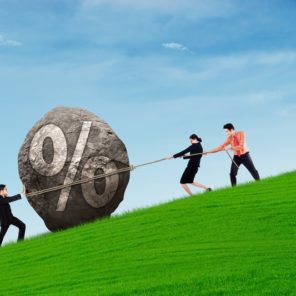Table of contents
A booming economy is great for the country but not for loan rates. The Federal Reserve Board (the Fed) keeps an eye on economic markers and adjusts federal interest rates up or down in response to changes. An uptick in economic activity can send inflation out of control, so rates increase to regulate prices, spending and borrowing. While this reflects a positive trajectory for the economy as a whole, it increases the cost of taking out a loan and can put small businesses owners in a bind. Rising federal rates pushed up business loan rates in 2019, and the trend may continue if the Fed follows through on an additional increase planned for 2020. Every time the federal interest rate jumps, it affects the rate banks charge on loans to their most creditworthy customers, known as the prime rate. High rates make paying loans off more difficult, especially for businesses with shaky credit histories. If you need funding when the Fed’s rates are climbing, then you’ll have to find ways to compare all of your available options, rather than applying in one place.
What Is the Interest Rate on a Business Loan in 2019?
Loan rates depend on many factors, but you can get an idea of the average range to expect from various lenders as you begin your search for a funding source:- Bank loans: 2% to 13%, with small banks starting at 2.48% and large banks starting at 2.55%
- SBA loans: 7.75% to 10.25%
- Online term loans: 7% to 100%
- Short-term loans: 8% to 99%
- Intermediate-term loans: 6% to 30%
- Equipment financing: 4% to 12.75%
- Lines of credit: 8% to 80%
- SBA 7(a): 7.25% to 9.75%
- SBA CDC/504: 3.72% to 7.145%
- SBA microloan: 6.5% to 13%
- Invoice factoring: 13% to 60%
- Merchant cash advance (MCA) 20% to 250%
Where to Find the Lowest Small Business Loan Interest Rates
For businesses able to meet the stringent qualification requirements, banks will almost always have the best loan rates. Online loans tend to cost slightly more, but are often the best choice, especially when you have an opportunity that requires cash in a short time window. They’re also the best way to go if your financial status doesn’t measure up to bank qualifications. Online lending options are expanding and beginning to rival banks as top choices for business owners in need of cash. What does this mean when you’re comparing prices? You have to consider your company’s credit score, financial standing, revenue and history before putting in your first application. If you’re confident you can qualify and wait out a long approval process, try a bank or SBA loan first. However, if you need funding in days or weeks instead of months, look for an alternative lender with:- Few or no additional fees
- Experience in your industry
- Flexible loan terms
- Dedicated advisors who will search to find you the best rates
How to Qualify for the Best Small Business Loan Rates
A strategic approach to budgeting and debt management can increase your chances of qualifying for better than the average small business interest loan rates. In addition to shopping around for the best value, you should also:- Maintain a good relationship with the bank or credit union where you have your business account
- Pay bills, vendors and suppliers on time to improve your credit score
- Improve cash flow and increase revenue
- Obtain collateral to secure future loans
- Make a plan to pay down debt and bring your debt-to-credit ratio below 30%
- Apply for a business credit card to increase available credit and improve credit utilization
- Invest in credit monitoring to keep an eye on your financial situation
- Work with an accountant or use bookkeeping services to manage your budget
- Wait until your business has been established for at least one year
- Get your business plan and financial projections in order
- Consider incorporating to keep personal and business funds separate
- Choose loans made specifically for your needs, such as equipment financing
- Apply for loans with longer terms






